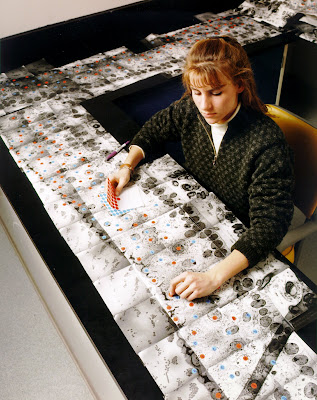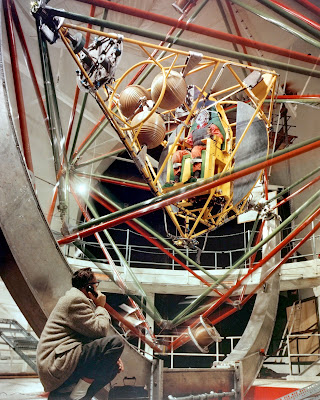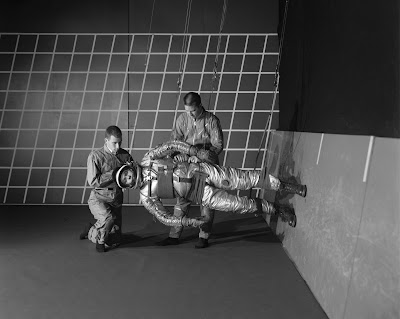Tuesday, September 30, 2008
The Most Advanced Quadruped Robot on Earth
BigDog is the alpha male of the Boston Dynamics family of robots. It is a quadruped robot that walks, runs, and climbs on rough terrain and carries heavy loads. BigDog is powered by a gasoline engine that drives a hydraulic actuation system. BigDog's legs are articulated like an animal’s, and have compliant elements that absorb shock and recycle energy from one step to the next. BigDog is the size of a large dog or small mule, measuring 1 meter long, 0.7 meters tall and 75 kg weight.
Saturday, September 27, 2008
Mapping out the Neural Networks

Mapping out the neural networks of the inner ear as part of Dr. Murial Ross's study of the effects of space travel at the NASA Ames Research Center, Mountain View, California.
Project Mercury Altitude Wind Tunnel Gimbaling Rig

MASTIF - Multiple Axis Space Test Inertia Facility - was developed for Project Mercury to train astronauts in gaining control over a spacecraft that could move in multiple directions at once--pitching, rolling and yawing all at the same time. This photo is similar to photo GPN-2000-001186, but not identical.
Manned Manuevering Unit

Mission Specialist Bruce McCandless II ventured further away from the confines and safety of his ship than any previous astronaut ever has. This space first was made possible by the Manned Manuevering Unit or MMU, a nitrogen jet propelled backpack. After a series of test maneuvers inside and above Challenger's payload bay, McCandless went "free-flying" to a distance of 320 feet away from the Orbiter. The MMU is controled by joy sticks positioned at the end of the arm rests. Moving the joy sticks left or right or by pulling them fires nitrogen jet thrusters propelling McCandless in any direction he chooses. A still camera is mounted on the upper right portion of the MMU. This stunning view shows McCandless with the MMU out there amongst the black and blue of Earth and space.
Iron Cross Attitude Simulator With Pilot
 NACA High-Speed Flight Station test pilot Stan Butchart flying the Iron Cross, the mechanical reaction control simulator. High-pressure nitrogen gas expended selectively by the pilot through the small reaction control thrusters maneuvered the Iron Cross through the three axes. The exhaust plume can be seen from the aft thruster. The tanks containing the gas can be seen on the cart at the base of the pivot point of the Iron Cross. NACA technicians built the iron-frame simulator, which matched the inertia ratios of the Bell X-1B airplane, installing six jet nozzles to control the movement about the three axes of pitch, roll, and yaw.
NACA High-Speed Flight Station test pilot Stan Butchart flying the Iron Cross, the mechanical reaction control simulator. High-pressure nitrogen gas expended selectively by the pilot through the small reaction control thrusters maneuvered the Iron Cross through the three axes. The exhaust plume can be seen from the aft thruster. The tanks containing the gas can be seen on the cart at the base of the pivot point of the Iron Cross. NACA technicians built the iron-frame simulator, which matched the inertia ratios of the Bell X-1B airplane, installing six jet nozzles to control the movement about the three axes of pitch, roll, and yaw.
Launch Phase Simulator at Goddard Space Flight Center

Goddard's Launch Phase Simulator or High-Capacity Centrifuge simulates vibration, G-forces and changing pressures that a spacecraft would encounter during launch and landing. To perform a test, which typically lasts one day, technicians place spacecraft components and even entire satellites in either the simulator's cylindrical test chamber (at the far left in this photo) or on its test platform at the other end (it was not installed when this photo was taken). Powered by two 1,250- horsepower motors, the facility then spins at up to 38.3 revolutions per minute to simulate a 30-g environment. (Most people experience about 2-g when they ride on a roller coaster.) Engineers monitor test results from an adjacent control room.
OMEGA

OMEGA (One-Man Extravehicular Gimbal Arrangement) shown here permits unlimited freedom, and was designed around a parallel pair of 32-inch-diameter thin-line angular-contact bearings with half the balls removed to minimize friction. Tests have been conducted with OMEGA subjects in flight suits and pressure suits to determine the best gimbal restraint system and operation techniques. The test subjects are suspended in a sling support from a single RDS cable. As they translate about, the RDS tracks them, keeping the cable vertical. The test subjects operate in an effectively zero-g environment in the horizontal plane.
EVA (Extra-vehicular activity aka spacewalk) Exercise Device
Ames 5 Degrees-of-Motion Simulator

The NASA Ames 5 degrees-of-freedom motion simulator. This simulator incorporated a centrifuge with a 30 foot spin radius. The simulated cockpit located within the hooded cab at the end of the centrifuge arm was driven by motors as required by the simulation about each of its three axes (pitch, roll, and yaw). The cab was also driven through a limited range of motion along the vertical axis and of course was driven by the centrifuge arm along a curved path of fixed radius in the horizontal plane. Thus the motions that could be simulated in the cab were three angular motions, one translational motion, and a curvilinear combination of the remaining two translational motions. The curvilinear motions and associated accelerations were of course, fairly representative of airplane flight. The simulator was placed in operation early in 1961.
Reduced Gravity Walking Simulator

A test subject being suited up for studies on the Reduced Gravity Walking Simulator located in the hangar at Langley Research Center. The initial version of this simulator was located inside the hangar. Later a larger version would be located at the Lunar Landing Facility. This position meant that a person's legs experienced only one sixth of their weight, which was the equivalent of being on the lunar surface. The purpose of this simulator was to study the subject while walking, jumping or running. Researchers conducted studies of various factors such as fatigue limit, energy expenditure, and speed of locomotion.
FusionMan Makes Historic Jet-Propelled Flight

Following in the vapor trail of aviator Louis Bleriot, Yves Rossy made a historic flight of his own across the English Channel this morning. Yesterday (26th September 2008) Rossy—also known as FusionMan—became the first human to cross using jet propulsion.
Popsci
Anti-gravity Pen
Tuesday, September 23, 2008
Invention: Muscle-fatigue blocker
Fatigue occurs when muscles become weaker with repeated or intense exercise, or as a result of an illness.
Researchers have long thought that fatigue is caused by a build-up of lactic acid in the muscles, but in the past decade, a number of teams have shown that this process does not cause fatigue (and may in fact prevent it).
Muscle-fibre cells contract when calcium ions are released inside them, under the control of ion channels called ryanodine receptors.
Now, a growing body of evidence suggests that fatigue is actually related to how these calcium ions are released and processed. It seems that the ryanodine receptors can behave erratically after excessive exercise or due to disease, allowing calcium ions to leak out inappropriately and leading to fatigue.
So Andrew Marks at Columbia University, New York, has developed a drug that can switch those receptors back to their stable state, making it harder for fatigue to set in.
His invention may make it possible for athletes, soldiers, or anyone else doing strenuous exercise, to stave off muscle fatigue for longer.
Read the full muscle-fatigue blocker patent application.
Monday, September 22, 2008
Neutral Buoyancy
Working underwater closely simulates the weightless environment encountered by spacewalking astronauts. The underwater environment helps them learn how to position their bodies and how to maneuver themselves during an EVA, or spacewalk. Since they are actually in pressurized spacesuits, they also have an opportunity to evaluate reach, access and visibility to specific work areas.




